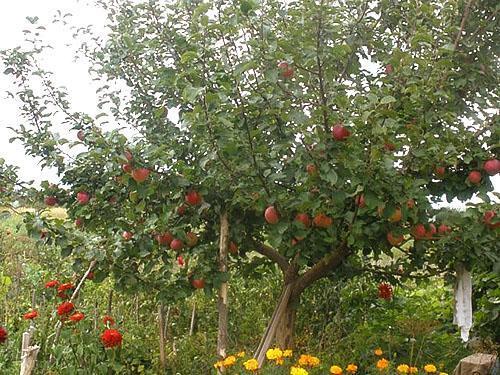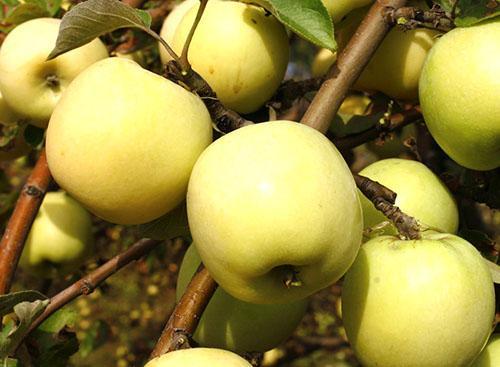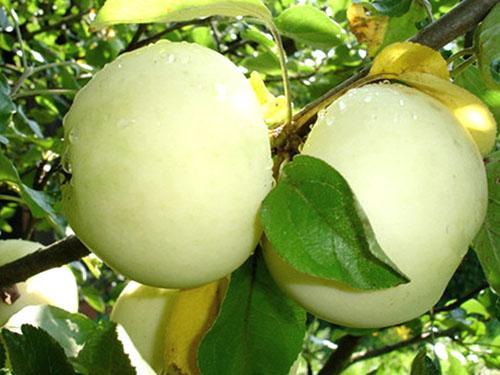Winter-hardy apple varieties for the Urals and Siberia
 The climate of the Urals and Siberia is characterized by a certain severity and unpredictability. Therefore, apple trees in this region must have adequate endurance and winter hardiness. At present, quite a lot of breeding varieties of columnar apple trees have been created that are able to grow and give a good harvest even in the most severe climatic latitudes. They can be divided into 3 groups.
The climate of the Urals and Siberia is characterized by a certain severity and unpredictability. Therefore, apple trees in this region must have adequate endurance and winter hardiness. At present, quite a lot of breeding varieties of columnar apple trees have been created that are able to grow and give a good harvest even in the most severe climatic latitudes. They can be divided into 3 groups.
- Ranetki - the most winter-hardy bush-shaped apple trees that have small fruits weighing no more than 15 g.
- Semi-crops - have a slightly lower winter hardiness, however, they tolerate normal winter normally. Grown in bushy form, fruit weight from 15 to 130 g.
- Stlantsy - large-fruited varieties with low winter hardiness. The formation of a creeping crown is in most cases performed artificially. In addition, several new varieties of natural shale have also been developed.
The most popular apple varieties for the Urals and Siberia are the following:
- Antonovka;
- White filling;
- Melba;
- Folding;
- Welsey;
- Silver Hoof;
- Autumn Gift;
- Summer Striped;
- Ural Nalivnoe.
However, the Ural region may not be entirely favorable even for specially bred varieties. For example, late frosts can negatively affect apple trees during flowering, killing the entire crop. Therefore, to create a garden, it is necessary to choose different varieties of apple trees, taking into account their growing season, frost and winter hardiness. Read the same about columnar apple trees on our website!
Apple-tree Antonovka

- large tree, with a spreading crown;
- the fruits of the Antonovka apple tree are large, weighing 125–150 g, with a yellowish-green peel;
- the pulp is white, juicy, tartaric;
- ripening of fruits - September;
- yield - 200-300 kg per tree;
- storage - 3 months;
- frost resistance is good;
- fruits are used fresh, for drying, preparation of compotes, juices, marmalade and pastilles.
Harvesting of Antonovka apple trees takes place in September, and consumer maturity occurs a month after harvesting.
Apple-tree White Pour
 Summer winter-hardy variety. Main characteristics:
Summer winter-hardy variety. Main characteristics:
- the height of the tree is medium, the crown is round, the stanza is easily formed;
- apple fruits White Pouring medium, weighing 100 - 150 g, rounded, with a greenish-yellow skin;
- the flesh is white, coarse-grained, sweet and sour;
- removable maturity occurs in August;
- the yield is 100 kg per tree;
- storage - 2 weeks;
- high resistance to frost, average to diseases;
- fruits are used fresh and for conservation.
The fruits of the White Naliv apple tree are unsuitable for long-term storage, because they quickly deteriorate. Therefore, it is best to use them for recycling.
Apple tree Melba
 Late summer Canadian variety. Main characteristics:
Late summer Canadian variety. Main characteristics:
- a tree of medium height, with a rounded crown, in the Urals and Siberia is grown in stanza;
- the fruits of the Melba apple tree are large, weighing 140-200 g. The peel is light green with a rich red blush;
- the pulp is snow-white, sweet and sour, with a caramel aroma;
- fruits ripen in August;
- yield - 120 kg per tree;
- storage in a cool room - until January;
- resistance to disease and frost is average;
- fruits are used fresh, for processing into compotes and juices.
The Melba apple tree forms many erect long shoots that make it difficult to form into an elfin. Therefore, additional pruning of branches and timely pinching are required.
Apple tree Papirovka
 Early summer stanza variety. Main characteristics:
Early summer stanza variety. Main characteristics:
- tree of moderate growth, with a dense rounded crown;
- fruits of apple tree Papirovka small, weighing up to 100 g, rounded, slightly ribbed, greenish-yellow peel;
- the flesh is white, loose, sweet and sour;
- fruits ripen in August;
- yield - 150-250 kg per tree;
- storage - 15-30 days;
- winter hardiness and disease resistance are good;
- a variety of universal use.
Apple tree Papirovka is self-fertile, the best pollinator for it is the Welsey variety.
Apple Wellsey
 Winter variety, imported from America. Main characteristics:
Winter variety, imported from America. Main characteristics:
- medium-sized tree with a pyramidal crown;
- fruits are medium, weighing 90–150 g, greenish-yellow rind with red blush;
- the flesh is white, with a pink tint near the peel, crispy, sweet and sour;
- Apple harvesting takes place in September-October;
- the yield is 150-200 kg per tree;
- storage - until January;
- winter and frost resistance is average;
- a variety of universal use.
The stanza crown of the Welsey apple tree is formed at a distance of 25–50 cm from the soil: by bending and pruning, the tree branches are held in this position throughout its life.
Apple Silverhoof
 Summer early-growing variety. Large semi-culture. Main characteristics:
Summer early-growing variety. Large semi-culture. Main characteristics:
- the tree is not tall, with a rounded branchy crown;
- fruits are small, one-dimensional, weighing 85 g, round. The peel is smooth, creamy, with an orange-red tint;
- the pulp has a fine-grained structure, juicy, sweet and sour;
- the fruits of the Silver Hoof apple tree ripen in August;
- yield - 160 kg per tree;
- storage - 4-6 weeks;
- resistance to disease and frost is high;
- fruits are used fresh and for processing.
It is necessary to regularly feed the Silverhoof apple tree and monitor the moisture level. Because with a decrease in soil fertility, the fruits can decrease in size, and with prolonged high humidity, the tree becomes vulnerable to scab.
Apple Tree Autumn Gift
 Autumn high-yielding variety. Main characteristics:
Autumn high-yielding variety. Main characteristics:
- tall tree with a rounded crown;
- the fruits of the Apple Gift of Autumn are large, weighing 140 g, flat-round, with yellow peel;
- the flesh is yellowish, sweet and sour, soft, does not darken for a long time;
- ripening of fruits - August-September;
- yield - 150 kg per tree;
- storage - 60 days;
- resistance to disease and frost is good;
- use is universal.
For pollination of apple trees Gift of Autumn, the Anis Sverdlovsky variety is best suited.
Apple Tree Summer Striped
 Early maturing summer variety. Main characteristics:
Early maturing summer variety. Main characteristics:
- the tree is medium-sized, has a compact crown;
- fruits are small, weighing 70–80 g, oblong-ovate, pink-red rind;
- the pulp is white, grainy, juicy, sweet and sour;
- ripening and eating fruits - July-August;
- Yield of the Summer Striped apple - 120 kg per tree;
- storage - 2–4 weeks;
- resistance to diseases is average, good to frost;
- use is universal.
The Apple-tree Summer Striped needs pollinators, the best of them are Kitayka cream, Miasskoye, Prizovoye.
Apple-tree Ural Nalivnoe
 Autumn breeding variety. Semi-culture. Main characteristics:
Autumn breeding variety. Semi-culture. Main characteristics:
- the tree is medium-sized, with a dense, round-drooping crown;
- fruits are small, weighing 28-30 g, round. The peel is smooth, glossy, yellow-green;
- the pulp is white, juicy, sweet and sour;
- consumer maturity of the Uralskoye Nalivnoe apple-tree begins in September-October;
- yield - 200 kg per tree;
- storage - 2 months;
- high resistance to frost;
- use is universal.
Depending on the way of consumption, there are 3 periods of maturity of the Ural Nalivnoe apple-tree:
- fruits are removed for processing into compotes and juices, when the pulp is still firm, but very juicy;
- for fresh consumption, apples are very tasty at this time, and the pulp is more tender;
- apples are used to make preserves, jams and marmalades.
Growing features
 Planting and caring for apple trees in the Urals and Siberia has some nuances. This especially applies to the winter period, during which trees require increased attention. The fact is that with strong and deep freezing of the soil, the root system of even very hardy varieties can be damaged. Therefore, for the winter, it is recommended to cover the periosteal circle with a layer peat and humus, 7-10 centimeters thick. And cover it with leaves and snow on top.
Planting and caring for apple trees in the Urals and Siberia has some nuances. This especially applies to the winter period, during which trees require increased attention. The fact is that with strong and deep freezing of the soil, the root system of even very hardy varieties can be damaged. Therefore, for the winter, it is recommended to cover the periosteal circle with a layer peat and humus, 7-10 centimeters thick. And cover it with leaves and snow on top.
To protect young apple trees from strong winds, it is recommended to tie them to a support installed near the seedling. You can also bind each branch to it separately.
Landing. It is possible to plant apple trees in the Urals in late autumn, so that the seedling does not have time to grow and is not damaged by frost. Or in early spring, after the last snow melts. In this case, by the arrival of real heat, the root system will adapt to the new soil, and the tree will begin to develop. For planting, it is recommended to choose a fertile, nitrogen-rich soil with deep groundwater.
Apple tree care traditionally consists of watering, feeding and pruning:
- Watering. Meticulous watering necessary for apple trees immediately after planting. In subsequent years, they are watered only in too dry years.
- Top dressing. After the tree has taken root and started growing, the apple tree must be fed. For this, it is recommended to use nitrogen, potash and phosphorus fertilizers. In order for the fertilizer to reach the root system faster, the tree must be watered after feeding.
- Pruning. Crown formation is performed one year after planting, and in subsequent years, preventive pruning is performed. In spring, it is recommended to prune branches to the maximum in order to activate their growth. This, in turn, promotes high yields and larger fruit sizes.